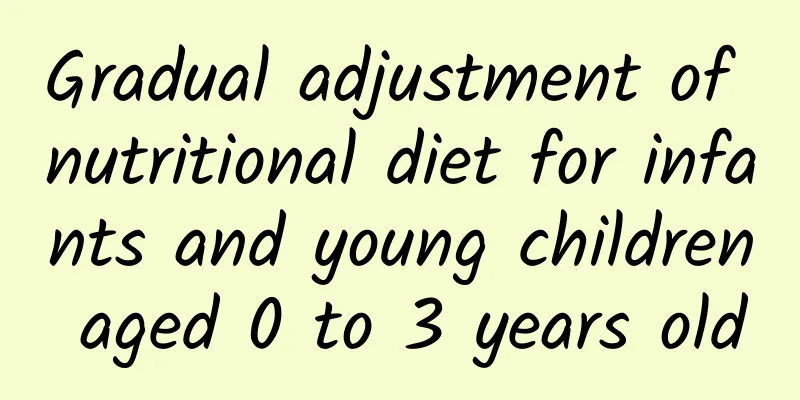Gradual adjustment of nutritional diet for infants and young children aged 0 to 3 years old

|
Many parents worry that their children will lose at the starting point and hope that their children eat as nutritiously as possible. In fact, gradually adjusting the diet is beneficial to the child's development. For newborn babies, breast milk or infant formula is the only source of nutrition. As they gradually develop and grow teeth, after about 4 months of age, the source of nutrition can be changed from all liquid to mushy food. At about 1 year old, they begin to transition to toddlerhood and enter the stage of eating solid food. The source of nutrition for infants before 4 months old is breast milk or formula milk. After 4 to 6 months, complementary foods can be gradually added. After 1 year old, solid food can be gradually tried. Children should be guided to develop a balanced diet habit. 4 months ago, breast milk is the main Babies have a reflex to push out solid objects with their tongues before 4 months old, so it is inappropriate to feed solid or semi-solid foods such as fruit puree with a spoon before 4 months old. For babies who are born at full term and develop normally, if their appetite is normal, whether they are fed breast milk or infant formula before 4 months old, it can provide complete nutrition and allow the baby to grow smoothly. In terms of breast milk, there are two signs that should be observed to determine whether the child is getting enough: slow weight gain (less than 500 grams per month, and weight still lighter than birth weight two weeks after birth) and low urine output (less than 6 times a day, and dark yellow urine with a strong odor). If these situations occur, you should discuss with your doctor to find out why your child is not eating enough. Try complementary foods at 4-6 months The pancreas, which is responsible for digestion, only matures slowly when the baby is 4 to 6 months old. Therefore, foods rich in starch, protein, and animal fat should be gradually introduced after 4 to 6 months. Two other indicators can also be observed as a reference for whether to add complementary foods: daily milk intake of more than 1,000 ml and weight gain of twice that at birth. Start with rice paste or porridge paste as complementary food, and then try other grains, root vegetables, or fruits and vegetables, such as mashed potatoes, mashed carrots, and mashed vegetables. These foods are less likely to be allergens. You can add a new dish every 3 or 4 days, and then slowly add mashed beans, mashed meat, and mashed eggs after 6 months. It is best to observe each of these proteins for a week before trying other items, and gradually let your child eat nutritionally balanced mashed foods. 1-3 years old to cultivate proper diet After the age of one, when solid food gradually becomes the staple food, it is important to pay attention to the child's eating behavior and cultivate eating habits. Many parents begin to monitor their children's meal times, which makes eating a chore. It is recommended to use a guiding approach. For example, children will most likely want to "eat by themselves", so you can prepare more food that is convenient for children to take by themselves, such as hand-torn toast, diced carrots, etc. The child's willingness to eat will be higher than being fed. The older children get, the more they are bound to be picky eaters. Parents should try to reduce their aversion to food. For example, you can mash the food that the child hates as much as possible and mix it with other foods so that the child cannot smell it. You can also change the cooking method to make the food more attractive in color, aroma and taste. Or you can let the child participate in the food preparation process, such as making sandwiches, to increase the child's interest in food. |
<<: Seeing through everyday life makes drugs invisible
>>: Baby's poor appetite, appetizing food, nutritional bonus
Recommend
Blood pressure soars when it’s cold, and complications are imminent! Nutritionist Cheng Hanyu: 6 types of food that lower blood pressure = the effect of 1 blood pressure pill
According to statistics from the Ministry of Heal...
What to check for cervicitis
Cervicitis is a common gynecological disease. If ...
What are the early symptoms of ovarian cysts and what are the dangers
What are the early symptoms of ovarian cysts? Wha...
What are the symptoms of polycystic ovary
Polycystic ovary is a disease in obstetrics and g...
Is congenital absence of vagina dangerous?
Is congenital absence of vagina harmful? I believ...
The reasons why endocrine disorders can easily induce vulvar leukoplakia
Most people think that vulvar leukoplakia is caus...
Premenopausal adjuvant endocrine therapy options
What should be chosen for premenopausal adjuvant ...
What is the reason for scanty menstruation? How to treat it?
Normal women have menstrual flow of 30 to 80 ml e...
The most important hazards of abortion
Abortion is an operation that many women who have...
Sexual life disorders can lead to the onset of uterine fibroids
The incidence of uterine fibroids is increasing. ...
What are the common factors that induce chronic adnexitis?
Adnexitis is a common chronic inflammation and th...
What should I do if the wipe turns brown on the sixth day of menstruation?
What should I do if the wipe turns brown on the s...
Let's take a look at how Chinese medicine views the cause of vulvar leukoplakia
Let's take a look at how Chinese medicine vie...
What is the reason for repeated pelvic inflammatory disease to turn into cancer?
Pelvic inflammatory disease What is the reason fo...
Long-term poor diet structure can induce the cause of ovarian cysts
Many women do not understand the cause of ovarian...









